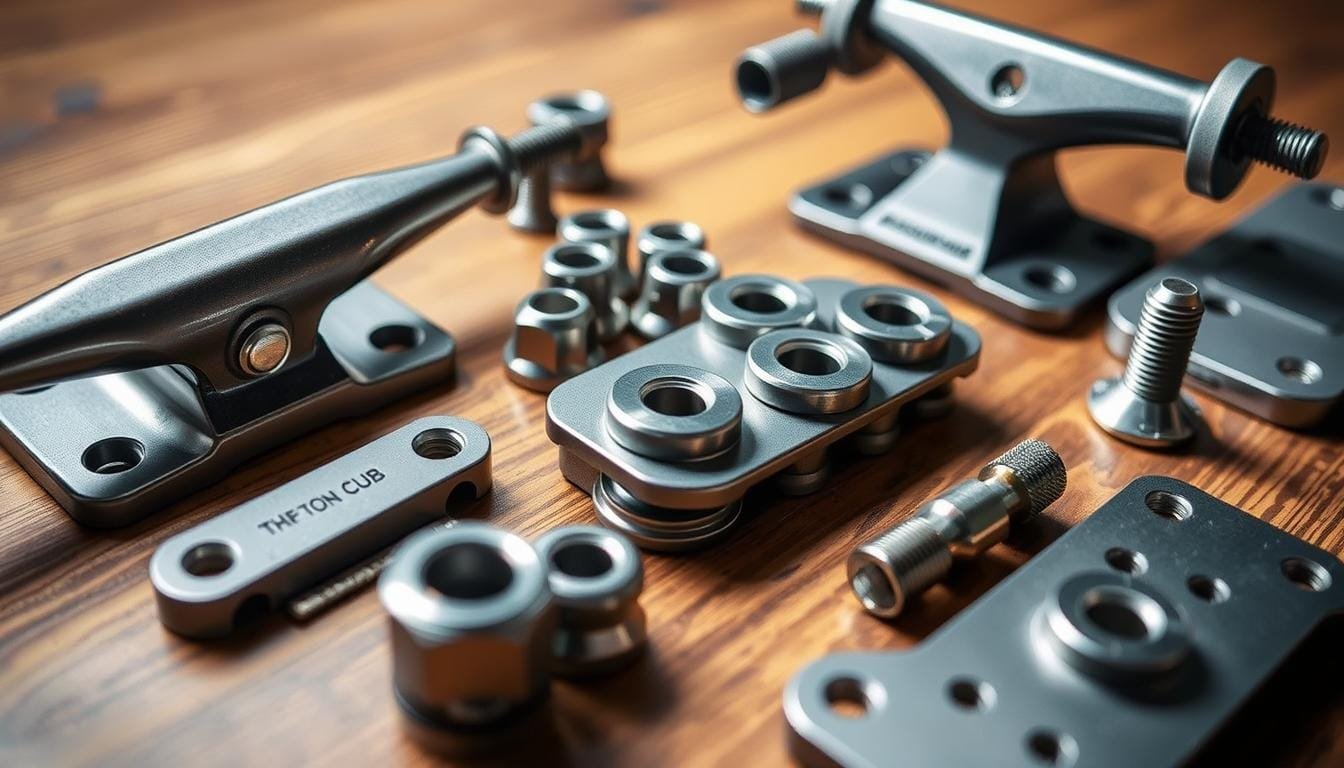Choosing the right bolts is key for a secure skateboard. Skateboard nuts and bolts, also known as hardware or bolt packs, are crucial for connecting your deck to the trucks. They’re made to fit perfectly, ensuring a setup that can handle tricks and riding well.
Skateboard bolt packs usually have eight bolts and eight ⅜” nuts with self-locking features. It’s important to regularly check these for wear and rust to keep your board in top shape. Knowing the right size when replacing bolts helps avoid problems like wheelbite, which can happen when using riser pads with big wheels.
Key Takeaways
- Skateboard hardware sets typically include eight bolts and eight ⅜” nuts.
- Avoid using household hardware due to improper sizing and lack of vibration resistance.
- Regularly check your skateboard hardware to prevent loosening and ensure a secure fit.
- Use appropriate bolt lengths, especially if riser pads are installed, to prevent wheelbite.
- Standard hardware size for 7-ply decks without riser pads is 7/8″, while 1/8″ riser pads require 1″ hardware.
Understanding Skateboard Bolt Basics
Skateboard bolts are essential for keeping your deck and trucks together. They come as Allen or Phillips head bolts. Each skateboard truck needs four bolts and nuts to stay attached to the deck.
Mounting kits have bolts made just for skateboards. These bolts have self-locking nuts to stay tight, even with board vibrations. It’s key to check your bolts for rust or wear and replace them as needed.
When picking skateboard bolts, think about if you’ll use riser pads. You’ll need longer bolts for them to fit right. Riser pads help avoid wheelbite with big wheels, keeping your ride smooth and secure.
Each truck gets attached with four bolts, making eight in total for your skateboard. Make it a habit to check these bolts to avoid accidents. Tighten them in an “X” pattern with a skate tool to spread the pressure evenly.
Types of Bolts You Can Use
There are two main types of skateboard bolts: Allen bolts and Phillips head bolts. Allen bolts have a hexagonal socket. They are liked for their sleek design and how easy they are to use. Phillips head bolts have a cross-shaped drive. They are known for being very versatile.
The choice between them is up to you and what your skateboard needs. Most skate tools and hardware kits have both types. This makes it easy to take care of your board.
Skateboard hardware comes in different styles like countersunk and raised head bolts. Countersunk bolts lie flat on the deck for a smoother ride. Longboarders might prefer Phillips pan head bolts for a better grip on bigger decks. Mudge Fasteners, with over 30 years of experience, says picking the right bolt is key for a good ride.
A normal set has eight bolts of the same size and eight ⅜” nuts with nylon inserts. This is perfect for attaching trucks to the board. Knowing these basics can really affect your board’s ride and durability. Now, let’s look at some differences between Allen bolts and Phillips head bolts in the table below:
| Bolt Type | Drive Type | Ideal Usage | Common Head Shapes |
|---|---|---|---|
| Allen Bolts | Hex Socket | All-around skateboarding | Countersunk, Raised |
| Phillips Head Bolts | Cross-shaped | Freestyle or longboarding | Flat, Pan |
If you’re using riser pads, you’ll need longer bolts. This ensures there’s enough space between the deck and wheels. Making sure you have the right size bolt is crucial. It impacts how your skateboard works and rides. Plus, the right bolts mean less chance of stripping, which Mudge Fasteners points out can stop your ride suddenly.
Bolt Sizing and Dimensions
Choosing the right skateboard bolts is key for a secure skateboard setup. The length needed for skateboard bolt sizing depends on if you use shock or riser pads. For skateboards without pads, shorter bolts are needed:
- Bolt length required without shock pads: 7/8” – 1”
- Bolt length required with 1/8” shock pads: 1” – 1 1/8”
- Bolt length required with 1/4” riser pads: 1 1/4”
- Bolt length required with 1/2” riser pads: 1 1/2”
The skateboard size and use of risers affect the needed skateboard bolt dimensions. Knowing this helps you choose the right bolts for your setup.
The bolt type you pick impacts your skateboard’s performance. Allen bolts are more popular than Phillips for their look and ease of use. Self-locking nuts help stop bolts from loosening up.
The normal bolt thread size is 10-32, fitting standard baseplate nuts. Wheel nuts are usually 5/16″-24, and kingpin nuts are 3/8″-24. Think about your skateboard setup’s thickness, around 7/8″, including the deck and nuts. Ensure your bolts extend about 1/8″ past the nut for a secure fit.
A well-fitted board enhances your skateboarding. By choosing the right skateboard bolt dimensions, your board will not only be correctly assembled. It will also perform at its best, giving you safety and fun during your rides.
Installation Tips for Your Bolts
Start by picking the right type and size of bolt for your skateboard. It’s key to make sure the bolts are long enough, which is really important when using riser pads. This ensures a secure fit while keeping your ride smooth. For beginners, a deck width between 7.5 and 8.5 inches provides good balance.
To securely fit the bolts, you’ll need some tools. These include a skateboard tool, screwdrivers, and hex keys. After your first few rides, check and tighten the nuts to keep your board stable. A T-tool will be handy to adjust the trucks and wheels. This improves how the skateboard moves and stays balanced. For more help, check out this detailed guide on putting a skateboard.
Keep your skateboard parts in good shape by cleaning and oiling the bearings regularly. Inspecting your setup for damage can also help avoid accidents. Making sure your bolts are tight is crucial for safe skateboarding.
- Skateboard tool
- 7/32” & 1/8” Allen wrenches
- Phillips screwdriver
- 3/8″ truck mounting hardware nut socket
- ½” kingpin nut socket
- 9/16″ axle nut socket
These tools will simplify the bolt installation on your skateboard, ensuring a solid connection between the deck and the trucks. Also, sites like Doctor Skate have great tips for assembling skateboards.
To enjoy a great skate, never skimp on part quality. Always use the correct tools for hassle-free and secure assembly.
Common Mistakes to Avoid
When putting your skateboard together, it’s key to dodge errors that can mess up your ride. A big slip is using just any nuts and bolts. Skateboards need special parts that won’t come loose easily. This keeps your board stable and safe.
Don’t overlook the state of your skateboard’s bolts and hardware. If they’re old or rusty, they can really make skating unsafe. It’s important to check and replace your skateboard’s parts to keep it riding smoothly.
Also, the length of the bolts matters a lot when adding riser pads or changing wheel sizes. If the bolts are too short or too long, you could face wheelbite. This makes it hard to steer and can be unsafe. So, avoiding these common setup errors will keep your skateboard working its best.

I’m John Peterson, a passionate skater, blogger, and lifelong enthusiast. I’ve been skating for over 9 years and have gone on to write a blog dedicated to the sport of skating and its culture. Through my blog, I strive to share my knowledge and experience of the sport with all who are interested. From beginner tips, tricks, and equipment reviews to interviews and event coverage, I cover it all. So read my blog as I explore the wonderful world of skating!

